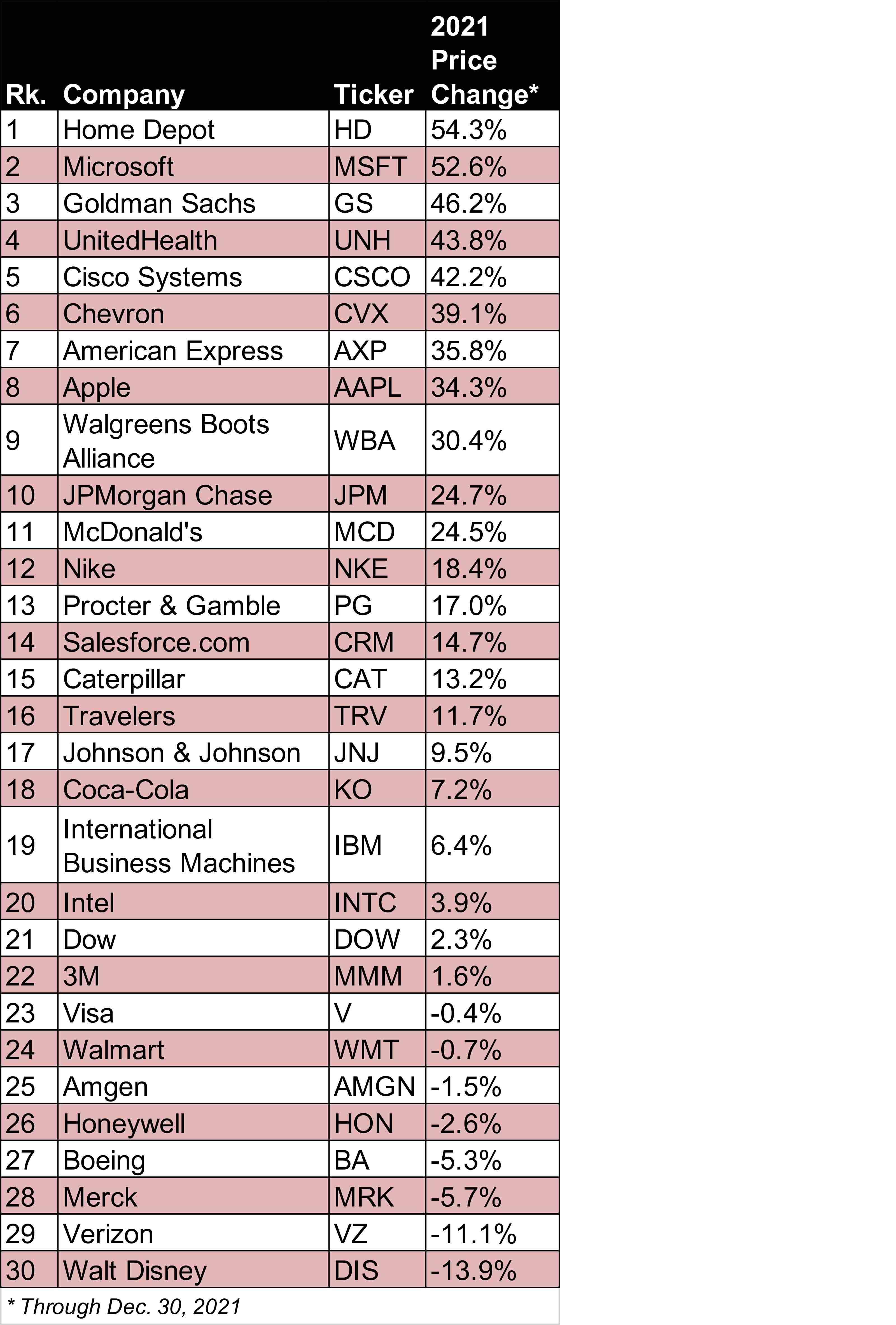The Best and Worst Dow Stocks of 2021
The Dow Jones Industrial Average produced well-above-average returns in 2021. But some of its venerable blue chips did far better ... while others left shareholders feeling shortchanged.


The Dow Jones Industrial Average shook off COVID-19, supply-chain snafus, inflationary pressures and myriad other worries to deliver an outstanding year in absolute terms. Indeed, the blue-chip bastion of Dow stocks generated a price gain of 19% through Dec. 30.
To get a sense of what an outlier 2021 was for the blue-chip average, the Dow's 30-year annualized price return comes to 8.7%.
Although the Dow as a whole powered through the pandemic, there's no question COVID-19 factored heavily in deciding the average's winners and losers in 2021, which we list in full down below. Naturally, the pandemic remains a key variable in the minds of Wall Street analysts as they rate the 30 Dow Jones stocks' prospects for 2022.
From just $107.88 $24.99 for Kiplinger Personal Finance
Become a smarter, better informed investor. Subscribe from just $107.88 $24.99, plus get up to 4 Special Issues

Sign up for Kiplinger’s Free Newsletters
Profit and prosper with the best of expert advice on investing, taxes, retirement, personal finance and more - straight to your e-mail.
Profit and prosper with the best of expert advice - straight to your e-mail.
Either way, many of this year's best Dow stocks are expected to continue their market-beating ways in the new year.
Take Home Depot (HD, $409.94) and Microsoft (MSFT, $339.32), for example. The Dow's top stocks of 2021 – each up by more than half – are forecast to put up more big gains in the year ahead thanks to a continuation of current trends.
In HD's case, the pandemic led to changes in consumer consumption patterns. Folks stuck at home decided to feather their nests, embrace do-it-yourself (DIY) projects and invest newfound discretionary income into their dwellings. The red-hot housing market also remains a tailwind at HD's back.
MSFT, meanwhile, has become a king of cloud-based services. The rise of remote work accelerated companies' embrace of Microsoft products such as Azure and Office 365. Looking ahead, analysts say enterprise customers are still in the early innings of their digital transformations.
On the other side of the ledger, analysts say some of this year's losers are set to become 2022's winners. Look no farther than Walt Disney (DIS, $155.93) for an example.
Disney was the Dow's worst stock in 2021, losing almost 14%. The media and entertainment conglomerate was essentially undone by the emergence of the Delta and Omicron variants of COVID-19. Anything that creates uncertainty around the health of Disney's all-important theme parks and resorts – not to mention its filmed entertainment business – is bad for DIS shareholders.
As much of a bummer as 2021 was for DIS, the Street gives shares a consensus recommendation of Buy, with fairly high conviction to boot. The pandemic can't last forever, the thinking goes, and shares look cheap.
Here's hoping, anyway.
Without further ado, have a look at how all 30 Dow stocks fared in 2021 in the table below:

Profit and prosper with the best of Kiplinger's advice on investing, taxes, retirement, personal finance and much more. Delivered daily. Enter your email in the box and click Sign Me Up.

Dan Burrows is Kiplinger's senior investing writer, having joined the publication full time in 2016.
A long-time financial journalist, Dan is a veteran of MarketWatch, CBS MoneyWatch, SmartMoney, InvestorPlace, DailyFinance and other tier 1 national publications. He has written for The Wall Street Journal, Bloomberg and Consumer Reports and his stories have appeared in the New York Daily News, the San Jose Mercury News and Investor's Business Daily, among many other outlets. As a senior writer at AOL's DailyFinance, Dan reported market news from the floor of the New York Stock Exchange.
Once upon a time – before his days as a financial reporter and assistant financial editor at legendary fashion trade paper Women's Wear Daily – Dan worked for Spy magazine, scribbled away at Time Inc. and contributed to Maxim magazine back when lad mags were a thing. He's also written for Esquire magazine's Dubious Achievements Awards.
In his current role at Kiplinger, Dan writes about markets and macroeconomics.
Dan holds a bachelor's degree from Oberlin College and a master's degree from Columbia University.
Disclosure: Dan does not trade individual stocks or securities. He is eternally long the U.S equity market, primarily through tax-advantaged accounts.
-
 A Contrarian Approach Pays Off for This Bond Fund
A Contrarian Approach Pays Off for This Bond FundThe Dodge & Cox Income Fund has outperformed in 2025 thanks to its managers' fearless approach.
-
 How AI Is Changing the Way Americans Spend on Live Events
How AI Is Changing the Way Americans Spend on Live EventsAI bots are reshaping ticket prices, resale markets and how fans shop. Here's what it means for your wallet and how to get the best deals on concerts, sports and shows.
-
 7 Outrageous Ways Retirees Can Invest Their Money in 2026
7 Outrageous Ways Retirees Can Invest Their Money in 2026Stocks and bonds aren't the only ways to invest your retirement "fun money."
-
 Stocks Extend Losing Streak After Fed Minutes: Stock Market Today
Stocks Extend Losing Streak After Fed Minutes: Stock Market TodayThe Santa Claus Rally is officially at risk after the S&P 500's third straight loss.
-
 If You'd Put $1,000 Into 3M Stock 20 Years Ago, Here's What You'd Have Today
If You'd Put $1,000 Into 3M Stock 20 Years Ago, Here's What You'd Have TodayMMM stock has been a pit of despair for truly long-term shareholders.
-
 Santa Claus Rally at Risk as Tech Stocks Slump: Stock Market Today
Santa Claus Rally at Risk as Tech Stocks Slump: Stock Market TodayThe Nasdaq Composite and Dow Jones Industrial Average led today's declines as investors took profits on high-flying tech stocks.
-
 These Were the Hottest S&P 500 Stocks of the Year
These Were the Hottest S&P 500 Stocks of the YearAI winners lead the list of the S&P 500's top 25 stocks of 2025, but some of the names might surprise you.
-
 Gold and Silver Shine as Stocks Chop: Stock Market Today
Gold and Silver Shine as Stocks Chop: Stock Market TodayStocks struggled in Friday's low-volume session, but the losses weren't enough to put the Santa Claus Rally at risk.
-
 The Santa Claus Rally Officially Begins: Stock Market Today
The Santa Claus Rally Officially Begins: Stock Market TodayThe Santa Claus Rally is officially on as of Wednesday's closing bell, and initial returns are positive.
-
 'Humbug!' Say Consumers, Despite Hot GDP: Stock Market Today
'Humbug!' Say Consumers, Despite Hot GDP: Stock Market Today"The stock market is not the economy," they say, but both things are up. Yet one survey says people are still feeling down in the middle of this complex season.
-
 Stocks Rise to the Spirit of the Season: Stock Market Today
Stocks Rise to the Spirit of the Season: Stock Market TodayInvestors, traders and speculators are beginning to like the looks of a potential year-end rally.